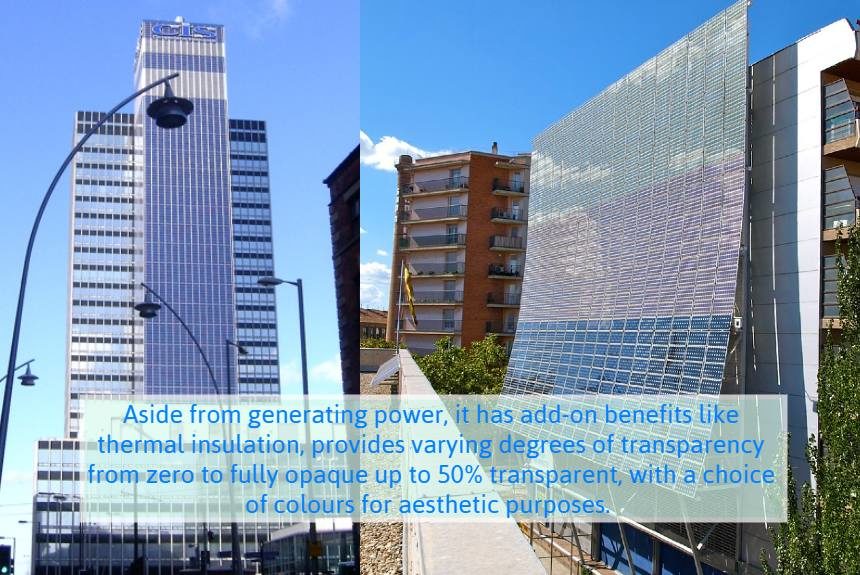Imagine your buildings’ roof, canopy, skylights, and windows generating energy for your power needs. You can do this by replacing your windows and sunroofs with photovoltaic glass.
It comes in various colours and varying degrees of transparency, from opaque to clear. Given the climate crisis, it is an attractive source of renewable and clean energy, reduces the building’s carbon footprint, and buffers rising energy prices.
Photovoltaic glass is composed of solar cells embedded between two glass panes. These PV glasses or solar glasses can now replace traditional construction materials such as glazing or cladding while also generating energy (Solar PV Knowledge, 2019).
In developed countries, commercial and residential buildings account for 20-40% of the total energy consumed (Ghosh, A., Sundaram, S., Mallick, T., 2019). The majority of energy consumption is from indoor heating, cooling, and lighting. Replacing glass windows and roofs with solar glass, especially in multi-storey buildings, has the potential to generate enormous amounts of clean energy while providing power for the building.
These PV glasses can also be customised. Aside from generating power, they have add-on benefits like thermal insulation. They provide varying degrees of transparency, from zero to fully opaque up to 50% transparent, with a choice of colours for aesthetic purposes. Recently, researchers have developed transparent solar cells, a breakthrough in PV glass engineering (Scully, 2019).
How is this transparency possible?
MIT researchers have been making these transparent solar cells. According to the MIT article, these solar cells “absorb only infrared and ultraviolet light, and this visible light passes through the cells unimpeded, so our eyes don’t know they are there”. Researchers at MIT have “deposited coating of their solar cells on various materials and used them to run electronic displays using ambient light.” So when “coating” these solar cells on windows of skyscrapers would not alter their looks but, more importantly, provide more than a quarter of the buildings energy needs without altering its looks (Transparent solar cells, 2013).
South Korea’s Ulsan National Institute of Science and Technology has also found a way to make these solar cells transparent by punching tiny holes into a one-centimetre square cell of crystalline silicone—a material commonly used to make solar cells. These holes are so tiny that they are the size of a human hair. The holes allow light to pass through them and create a transparency effect (Scully, 2019).
Solar PVs can generate power up to 70-80%. A standard domestic usage can reduce 2 to 3 tonnes of its carbon footprint, and a 50kWp non-residential building can cut 25 tonnes of its carbon footprint (Why Choose Solar, 2019).
Solar cells are only getting better and more efficient for both domestic and commercial use.
The creation of transparent solar cells is indeed a game-changer. It provides more climate adaptation options and flexibility for users while generating clean and renewable energy and reducing our carbon footprint.
Source:
Solar PV Knowledge Bank. Solar Glass. (2019) UK Spirit Energy. Retrieved from https://www.spiritenergy.co.uk/kb-solar-glass-photovoltaic-windows
Ghosh, A., Sundaram, S., & Mallick, T. (2019, February). Colour properties and glazing factors evaluation of multicrystalline based semi-transparent Photovoltaic-vacuum glazing for BIPV application. Renewable Energy. Volume 131. Pages 730-736. Retrieved from https://www.sciencedirect.com/science/article/pii/S0960148118308851?via%3Dihub
Scully, R.P. (2019, December 11). Punching holes in solar cells turn them into transparent windows. New Scientist [Article]. Retrieved from https://www.newscientist.com/article/2226881-punching-holes-in-solar-cells-turns-them-into-transparent-windows/
Stauffer, N.W. (2013, June 20). Transparent solar cells. MIT Energy Initiative [News]. Retrieved from http://energy.mit.edu/news/transparent-solar-cells/
Why choose Solar Energy and PV? (2019). UK Spirit Energy. Retrieved from https://www.spiritenergy.co.uk/kb-solar-pv-why-choose-solar-energy
PHOTO CREDIT:
- By User:Pit-yacker – Own work I took it, CC BY-SA 2.5, Link
- By Chixoy – Own work, Public Domain, Link



Leave a Reply